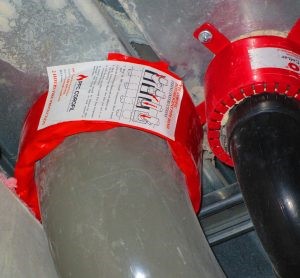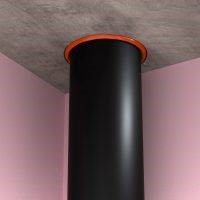FIRE COLLARS AND WRAPS TO SOFFITS
In this Bitesize CPD we will be looking at the use and installation of pipe wraps and fire collars as used for firestopping to concrete soffits.
These are often used incorrectly and we will show the most common defects picked up by FCM’s Clerks of Works during their site inspections.

The above was offered to us as a solution to provide a 1 hour fire barrier to a concrete soffit by a very large and well known main contractor. We could laugh but as we all appreciate, fire is no joke.
In the past and to some extent even now, fire stopping has not been on the site managers’ radar. It has been farmed out to dry liners, site labourers or anybody who would not add cost to the contractor.
Fortunately this attitude has begun to change and Fire protection is being considered from the inception of a project. Contractors are beginning to provide proper solutions.
Fire Collars

Pipe collar incorrectly fitted and in the wrong location
Pipe collars are designed to be fitted over plastic pipes that are fully surrounded by concrete or grouted in place.

Correctly fitted fire collar
They are made of a powder coated, split/hinged, cylindrical, steel collar. These are opened and fitted around the pipe. The steel shell contains a heat reactive graphite based intumescent material which expands in fire conditions and seals the gap left by the burned pipe.
The collar must be firmly held in position and must not rely on the pipe in any way for support. The minimum recommended size of non-combustible anchor bolt is 6mm dia. X 25mm long.
If the soffit (underside) of the concrete is very uneven, it is recommended to bed the collar onto a bead of Intumescent Mastic. Alternatively silicone mastic, to improve the smoke seal efficiency.
Pipe Wraps

Pipe wrap fitted in the wrong location
Here the installer managed to get it wrong even though there is a correctly fitted collar next to it and clearly visible instructions on the wrap.
Pipe Wraps comprise layers of a graphite-based intumescent sheet encapsulated in a polythene sheath. The product is designed to be wrapped around the outside diameter of the pipework or trunking and is secured by means of a self-adhesive strip.
The Intumescent Pipe Wrap is then positioned within the compartment wall or floor so that the edge of the product is left exposed at the face of the wall or soffit.
The Intumescent Pipe wrap is then sealed into the structure with Firestop motor/compound. Under fire conditions, the intumescent material expands against the structure and fills the void left by the burnt-out plastic pipe.
Important: If you are using permanent mineral wool shuttering for Firestop Compound, cut out the shuttering to ensure that the bottom edge of the Pipe Wrap can be viewed from the soffit below. If this is not carried out the intumescent material will be insulated and shall lead to a product malfunction.
Seal the Pipe Wrap into the structure with Firestop Compound or concrete, ensuring that there is a minimum of 25mm cover over the top of the Pipe Wrap.

A correctly fitted pipe wrap
If the wrap is buried into the grout or compound it may cause difficulties during later fire compliance inspections. The inspector may not be able to confirm that there is one in place and may ask for it to be exposed. Far easier to instruct that wraps are installed as above for the removal of later doubt.
Below is a short video from Hilti on fire products in action:
Steve Farrell
T: 07714234380
E: stevefarrell@fcmltd.co.uk
L: linkedin.com/in/stevefarrellfcmFox Curtis Murray are a building consultancy specialising in providing Clerks of Works services and Quality Control inspections.
- Subscribe to Our Newsletter


